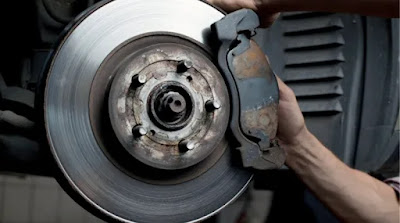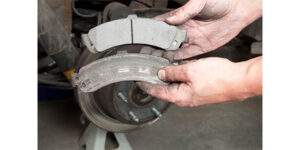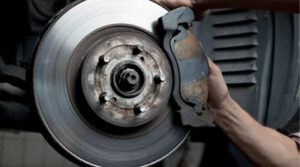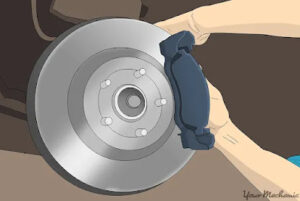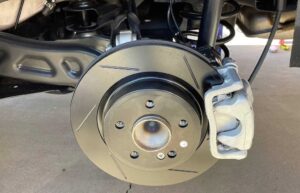Brake pads play a crucial role in a vehicle’s braking system. They are the components that make contact with the brake rotors to slow down or stop the vehicle. Without properly functioning brake pads, the braking system would not be able to effectively stop the vehicle, putting the driver and passengers at risk. Therefore, it is essential to maintain and replace brake pads regularly to ensure safe and efficient driving.
How Often Should You Replace Your Brake Pads?
The lifespan of brake pads can vary depending on several factors. One of the main factors is driving habits. Aggressive driving, such as frequent hard braking or riding the brakes, can wear down brake pads faster. Another factor is the type of brake pads used. Different types of brake pads have different levels of durability.
As a general guideline, it is recommended to replace brake pads every 30,000 to 70,000 miles. However, it is important to note that this is just an estimate and the actual lifespan of brake pads can vary. It is always best to consult the vehicle’s owner’s manual or a professional mechanic for specific recommendations based on the make and model of your vehicle.
How Long Do Brake Pads Last?
On average, brake pads can last anywhere from 30,000 to 70,000 miles. However, this can vary depending on several factors. One of the main factors is the type of brake pads used. There are three main types of brake pads: organic, semi-metallic, and ceramic. Organic brake pads are made from natural materials and tend to wear out faster. Semi-metallic brake pads are made from a combination of metal and other materials, offering better durability. Ceramic brake pads are made from ceramic fibers and tend to last the longest.
Other factors that can affect the lifespan of brake pads include driving conditions, driving habits, and the weight of the vehicle. Driving in stop-and-go traffic or in hilly areas can wear down brake pads faster. Aggressive driving habits, such as frequent hard braking, can also shorten the lifespan of brake pads. Additionally, heavier vehicles tend to wear down brake pads faster than lighter vehicles.
Choosing the Right Brake Pads for Your Vehicle
When it comes to choosing brake pads for your vehicle, there are several factors to consider. The first factor is the type of brake pads. As mentioned earlier, there are three main types: organic, semi-metallic, and ceramic. Each type has its own advantages and disadvantages, so it is important to choose the one that best suits your needs.
Another factor to consider is the quality of the brake pads. It is always best to choose high-quality brake pads from reputable manufacturers. Cheap or low-quality brake pads may not offer the same level of performance and durability, putting your safety at risk.
Additionally, it is important to consider the specific make and model of your vehicle. Different vehicles may require different types of brake pads, so it is important to consult the vehicle’s owner’s manual or a professional mechanic for specific recommendations.
Tips for Proper Brake Pad Installation
Proper installation of brake pads is crucial for their performance and longevity. Improper installation can lead to uneven wear, reduced braking performance, and even damage to other components of the braking system. Therefore, it is important to follow these tips for ensuring proper installation:
1. Clean the brake caliper and rotor before installing new brake pads. This will help ensure proper contact between the brake pads and the rotor.
2. Use a high-quality brake pad lubricant on the back of the brake pads. This will help reduce noise and vibration and ensure smooth operation.
3. Make sure the brake pads are properly aligned with the rotor. They should be centered and parallel to the rotor.
4. Tighten the brake pad retaining clips or pins to the manufacturer’s specifications. Over-tightening or under-tightening can cause problems.
5. After installing the brake pads, pump the brake pedal a few times to ensure proper seating and contact between the brake pads and the rotor.
Signs of Worn Brake Pads and When to Replace Them
It is important to be aware of the signs of worn brake pads so that you can replace them before they become a safety hazard. Some common signs of worn brake pads include:
1. Squeaking or squealing noises when applying the brakes. This can indicate that the brake pads are worn down and need to be replaced.
2. Grinding or scraping noises when applying the brakes. This can indicate that the brake pads are completely worn down and the metal backing is making contact with the rotor.
3. Reduced braking performance. If you notice that it takes longer for your vehicle to come to a stop or if you have to apply more pressure to the brake pedal, it may be a sign that the brake pads are worn down.
4. Vibration or pulsation in the brake pedal. This can indicate that the brake pads are unevenly worn or that there is a problem with the braking system.
If you notice any of these signs, it is important to have your brake pads inspected and replaced as soon as possible. Driving with worn brake pads can be dangerous and can lead to further damage to the braking system.
How to Extend the Lifespan of Your Brake Pads
While brake pads will eventually wear out and need to be replaced, there are several tips you can follow to maximize their lifespan:
1. Avoid aggressive driving habits, such as frequent hard braking or riding the brakes. This can wear down brake pads faster.
2. Maintain a safe following distance from the vehicle in front of you. This will allow you to anticipate stops and apply the brakes gradually, reducing wear on the brake pads.
3. Avoid driving in stop-and-go traffic whenever possible. This type of driving can wear down brake pads faster.
4. Have your braking system inspected regularly by a professional mechanic. They can check the condition of the brake pads and other components of the braking system and make any necessary repairs or replacements.
5. Avoid excessive weight in your vehicle. Heavier vehicles put more strain on the braking system, causing brake pads to wear down faster.
The Benefits of Regular Brake Maintenance
Regular brake maintenance, including maintaining and replacing brake pads, offers several benefits:
1. Safety: Properly functioning brake pads are essential for safe driving. Regular maintenance ensures that your brakes are in good working condition, reducing the risk of accidents.
2. Performance: Worn brake pads can reduce braking performance, making it harder to stop the vehicle. Regular maintenance ensures that your brakes are performing at their best.
3. Cost savings: Regular maintenance can help identify and address any issues with the braking system before they become major problems. This can save you money on costly repairs down the line.
4. Longevity: By properly maintaining and replacing brake pads, you can extend the lifespan of your braking system, saving you money on frequent replacements.
Common Brake Pad Problems and How to Fix Them
While regular maintenance can help prevent many brake pad problems, there are some common issues that may arise:
1. Uneven wear: Uneven wear can occur if the brake pads are not properly aligned or if there is a problem with the braking system. This can cause reduced braking performance and noise. To fix this issue, the brake pads may need to be realigned or replaced.
2. Brake fade: Brake fade occurs when the brake pads overheat and lose their ability to grip the rotor effectively. This can cause reduced braking performance and longer stopping distances. To fix this issue, the brake pads may need to be replaced with ones that can handle higher temperatures.
3. Brake noise: Brake noise, such as squeaking or squealing, can occur if the brake pads are worn down or if there is a problem with the braking system. To fix this issue, the brake pads may need to be replaced or the braking system may need to be inspected for any underlying issues.
4. Brake pulsation: Brake pulsation occurs when the brake pads and rotors are not properly aligned, causing a pulsating sensation in the brake pedal. To fix this issue, the brake pads and rotors may need to be resurfaced or replaced.
Conclusion: Taking Care of Your Brakes for Safe and Efficient Driving
In conclusion, maintaining and replacing brake pads regularly is essential for safe and efficient driving. By understanding the importance of brake pad maintenance, knowing when to replace them, choosing the right brake pads for your vehicle, properly installing them, and being aware of the signs of worn brake pads, you can ensure that your braking system is in good working condition. By following tips for extending the lifespan of your brake pads, regularly maintaining your brakes, and addressing any common brake pad problems, you can enjoy the benefits of safe and efficient driving. Remember, taking care of your brakes is not only important for your safety but also for the safety of others on the road.
